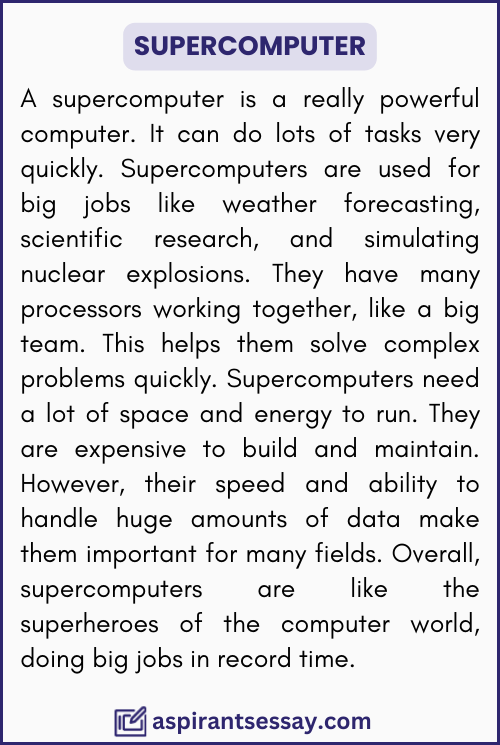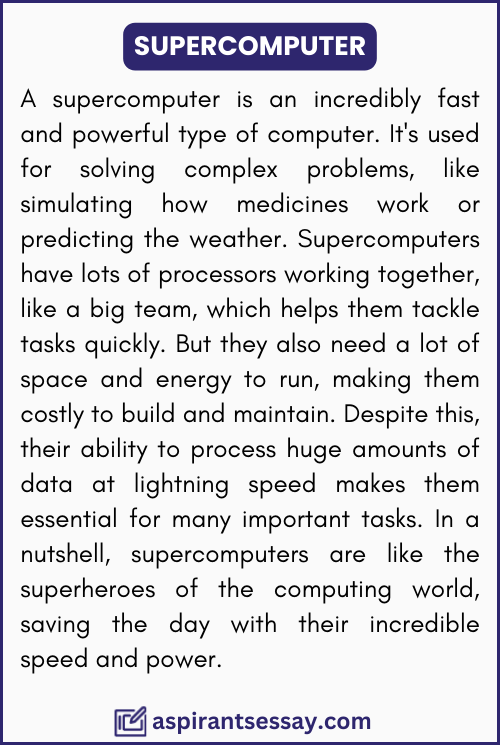Supercomputers, the pinnacle of computational prowess, revolutionize data processing across myriad domains. Their unparalleled speed, scalability, energy efficiency, memory capacity, and accessibility drive groundbreaking research and innovation. This introductory overview sets the stage for a deeper exploration of their multifaceted significance in modern computing.
(Here, we’ve presented paragraphs in 100, 150, 200 & 250 word samples. All the paragraphs will be helpful for students of all classes i.e. Nursery, LKG, UKG & class 1 to class 12).
Paragraph on Supercomputer in 100 Words
Sample 1
A supercomputer is a really powerful computer. It can do lots of tasks very quickly. Supercomputers are used for big jobs like weather forecasting, scientific research, and simulating nuclear explosions. They have many processors working together, like a big team. This helps them solve complex problems quickly. Supercomputers need a lot of space and energy to run. They are expensive to build and maintain. However, their speed and ability to handle huge amounts of data make them important for many fields. Overall, supercomputers are like the superheroes of the computer world, doing big jobs in record time.

Sample 2
A supercomputer is a very fast and powerful computer. It can solve difficult problems quickly. Supercomputers are used for things like predicting the weather, doing scientific research, and simulating things like nuclear explosions. They have many processors working together, like a big team. This helps them do tasks faster. Supercomputers need a lot of space and energy to work. They are expensive to build and keep running. But because they are so fast and can handle lots of data, they are important for many things. Overall, supercomputers are like the superheroes of the computer world, getting big jobs done in no time.
Sample 3
A supercomputer is an incredibly fast and powerful type of computer. It’s used for solving complex problems, like simulating how medicines work or predicting the weather. Supercomputers have lots of processors working together, like a big team, which helps them tackle tasks quickly. But they also need a lot of space and energy to run, making them costly to build and maintain. Despite this, their ability to process huge amounts of data at lightning speed makes them essential for many important tasks. In a nutshell, supercomputers are like the superheroes of the computing world, saving the day with their incredible speed and power.

Supercomputer Paragraph in 150 Words
Supercomputers represent the zenith of computational power, enabling the processing of vast amounts of data at unparalleled speeds. Their significance lies in their ability to tackle complex problems across various domains, ranging from weather forecasting and climate modeling to drug discovery and astrophysics simulations. These machines employ massive parallel processing, harnessing numerous processors to execute tasks concurrently, thereby accelerating computation. However, their construction and maintenance demand substantial resources, both in terms of finances and energy consumption.
Despite their high costs, supercomputers play a crucial role in advancing scientific research and technological innovation. They empower researchers and scientists to delve deeper into intricate phenomena, unraveling mysteries and pushing the boundaries of knowledge. Moreover, supercomputers contribute to societal progress by facilitating advancements in fields like healthcare, engineering, and environmental science. Their unparalleled computational capabilities make them indispensable tools for addressing some of the most pressing challenges facing humanity.
In essence, supercomputers embody the pinnacle of computational achievement, serving as indispensable instruments for tackling complex problems and driving innovation across diverse disciplines. While their development and maintenance pose significant challenges, their transformative impact on scientific discovery and societal advancement underscores their pivotal role in shaping the future.
Paragraph Writing on Supercomputer in 200 Words
Supercomputers represent the pinnacle of computational power, boasting immense processing capabilities far beyond conventional computers. These machines excel in handling vast volumes of data and executing complex calculations at extraordinary speeds. Their significance lies in their ability to tackle intricate scientific simulations, weather forecasting, nuclear research, and more, tasks that require immense computational resources. Supercomputers are crucial for advancing scientific knowledge and technological innovation, enabling breakthroughs in fields like medicine, climate science, and aerospace engineering.
One crucial aspect of supercomputers is their architecture, typically comprising thousands of interconnected processors working in tandem. This parallel processing architecture allows them to divide tasks into smaller, manageable chunks and solve them concurrently, significantly accelerating computations. Additionally, supercomputers require robust cooling systems to dissipate the immense heat generated by their operations, ensuring optimal performance and longevity.
Another key point is their cost and energy consumption. Building and maintaining supercomputers entail substantial investments due to their specialized hardware, infrastructure, and skilled personnel requirements. Moreover, these machines demand massive amounts of electricity to operate, contributing to their high operational costs and environmental footprint.
Despite their challenges, supercomputers play an indispensable role in advancing scientific research and solving complex real-world problems. Their unparalleled computational prowess empowers scientists and engineers to push the boundaries of knowledge and innovation, driving progress across various disciplines. As technology continues to evolve, supercomputers will remain invaluable tools for addressing humanity’s most pressing challenges and unlocking new frontiers of discovery.
Writing Paragraph on Supercomputer in 250 Words
Supercomputers stand at the zenith of computational power, enabling feats of data processing that are vital across numerous fields. Firstly, their unmatched processing speed sets them apart. With thousands of interconnected processors, supercomputers can execute complex calculations at breathtaking rates. This capability is indispensable for tasks requiring immense computational resources, such as climate modeling, genomic analysis, and simulating nuclear reactions. Moreover, their parallel processing architecture allows them to divide tasks into smaller components and solve them simultaneously, exponentially reducing processing times.
Secondly, the scalability of supercomputers is paramount. They can be expanded by adding more processors or interconnected nodes, enabling them to accommodate growing computational demands. This scalability ensures that supercomputers remain at the forefront of technological advancement, capable of handling increasingly complex simulations and analyses.
Thirdly, energy efficiency is a crucial aspect of supercomputing. Despite their immense computational power, supercomputers are designed to minimize energy consumption per computation, employing advanced cooling systems and energy-efficient components. This focus on energy efficiency is not only environmentally responsible but also economically viable, as it reduces operational costs and mitigates the environmental impact of supercomputing facilities.
Furthermore, supercomputers boast unparalleled memory and storage capabilities. They utilize high-speed memory and massive storage arrays to efficiently manage and process vast datasets, essential for tasks like big data analytics and machine learning. This ability to handle and analyze large volumes of data in real time empowers researchers and engineers to extract valuable insights and make informed decisions.
Lastly, the accessibility of supercomputing resources is crucial for fostering innovation and collaboration. Many supercomputing centers offer remote access to their facilities, democratizing access to computational resources and enabling researchers from diverse backgrounds to leverage the power of supercomputers for their work. This accessibility facilitates interdisciplinary collaboration and accelerates scientific discovery and technological innovation on a global scale.

Great paragraph! Your concise and clear explanation of supercomputers effectively captures their importance and capabilities. It’s a useful read for anyone looking to understand these powerful machines. Thanks for the informative content!